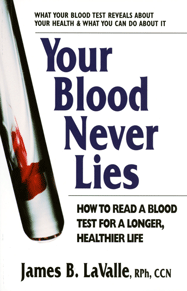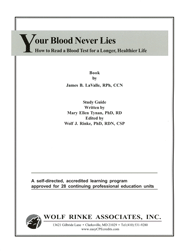|
Your Blood Never Lies:
How to Read a Blood Test for a Longer, Healthier Life
Book by James B. LaValle, RPh, CCN
Study Guide written by Mary Ellen Tynan, PhD, RD
Edited by Wolf J. Rinke, PhD, RDN, CSP
Book, 351 pgs and Study Guide with 1 Reporting Form, 24 pgs.
Clinical pharmacist, Dr. LaValle, explains in easy-to-understand language, all the information found on a typical lab report--the medical terminology, the numbers and percentages, and the laboratory jargon--so that you can help your patients better understand the significance of each biological marker being measured. He also recommends the most effective standard and complementary treatments for dealing with any problematic findings. Rounding out the book are explanations of lab values that do not appear on the typical blood test, but that should be requested for a more complete picture of your patients current physiological condition, so that they can take control of their lives.
Upon completion of this CPE program you will be better able to:
- Discuss routine and optional blood testing with patients to help them achieve optimal health.
- Interpret blood test results and patterns that may indicate patients are at risk for certain conditions.
- Assist clients on the proper selection and use of dietary supplements.
- Assess how drug treatment of certain conditions can affect the trending of laboratory values and risk of other conditions.
- Recommend conventional and natural therapies to normalize blood values.
For more information and customer comments, click
here.
Approved/Accepted by CDR, NCBDE
For RDs/RDNs & DTRs/NDTRs for the Professional Development
Portfolio
SUGGESTED Performance Indicators (PIs):
8.1.2, 8.1.3, 8.1.4, 8.1.5, 8.3.1, 8.3.6, 10.1.2, 10.2.1, 10.2.5, 10.2.7, 10.2.9, 10.4.1, 10.4.2, 10.4.3
DON'T SEE your Performance Indicators Listed here?
There are many Performance Indicators (PIs) that are applicable but we can't list them all &
Per CDR you may use ANY PI as long as it relates to your Learning Plan.
For details click here.
Share with a friend and Save!
Click here for important information about
sharing.
To order an ADDITONAL Reporting Form click below:
| C265F |
28 CPEUs |
REPORTING FORM |
|
|
Your Blood Never Lies:
How to Read a Blood Test for a Longer, Healthier Life
Book by James B. LaValle, RPh, CCN
Study Guide written by Mary Ellen Tynan, PhD, RD
Edited by Wolf J. Rinke, PhD, RDN, CSP
©2015 Wolf Rinke Associates. No part of this
publication may be reproduced, stored in a retrieval system, or transmitted
in any form or by any means, electronic, mechanical, photocopying,
recording, scanning, or otherwise, without the prior written permission
of the Publisher.
CUSTOMER COMMENTS
Cheryl Ripley: "Well-organized course and to the point; offers the answer key to check my answers. Interesting topic, self-check to see if I answered questions on quiz correctly."
Karla Vliet: "Easy to follow book and when I had a question about any of the questions I really like the quick reference to pages to review as I needed."
Jennifer Fielden: "This book was clear, concise and easy to read. I loved the charts! Great information on ways to deal with specific markers when they are both high and low. This book will definitely be a useful tool for me to use with my clients."
OVERVIEW AND INTRODUCTION
Welcome to the pre-approved, accredited CPE program for Your Blood Never Lies. The program consists of a book of the same title by James B. LaValle, RPh, CCN, and this study guide. The CPE program is designed to enable you to interpret blood test results and patterns that may indicate patients are at risk for certain conditions in the future, so that you can help them make lifestyle and dietary changes which lead to a healthier life. It is also designed to help you earn 28 Level 2, Continuing Professional Education Units (CPEUs). To get the most out of this CPE program, it is suggested that you adhere to the following four steps:
- Review the objectives in this study guide.
- Read and study the book.
- Assess what you have learned by answering the self-assessment questions in this study guide.
- Compare your answers to the answer key, which you will find at the end of the study guide. If you scored at least 80% (40 questions) correct, you have completed the program and are ready to transfer your answers to the CONTINUING PROFESSIONAL EDUCATION REPORTING FORM in front of this study guide. If you scored less than 80% correct, re-read the appropriate sections of the book and until you score at least 80% correct.
After you have successfully completed the program, complete the CPE REPORTING FORM and:
Submit on-line at www.easyCPEcredits.com,
Or fax to: (410) 531-9282,
Or mail to: Wolf Rinke Associates, 721 Valley Forge Road #486, Valley Forge, PA 19481
We will email your Certificate of Completion.
When you submit your CPE Reporting Form to us via www.easyCPEcredits.com, fax, or mail be sure to write your correct email address in the space provided on the CPE Reporting Form. If writing by hand, be sure to print your email address clearly.
To ensure that our emails are delivered to your inbox (instead of your junk/spam folders), please add cpesupport@wolfrinke.com to your Address Book or Safe List of allowed email senders. Also, be sure to allow attachments from this email address.
Please NOTE the following errors in the book, Your Blood Never Lies:
The chart on p. 159 should read: "Supplements for Low Albumin" not high Albumin.
The box on p. 261, labeled "Consider This", should read in part: "The best time to take a cortisol test is in the morning, between 7 and 9 a.m., when cortisol levels are highest;" not lowest.
LEARNING OBJECTIVES
Upon completion of this CPE program you will be better able to:
-
Guide patients in becoming more proactive concerning their health.
-
Discuss routine and optional blood testing with patients to help them achieve optimal health.
-
Educate patients on how to read and interpret their lab results at a point in time as well as interpreting trends over time.
-
Communicate potential health benefits derived from understanding what blood tests reveal.
-
Educate clients on the common causes, symptoms and potential complications of abnormal blood levels.
-
Interpret blood test results and patterns that may indicate patients are at risk for certain conditions.
-
Educate clients on positive changes in diet and behavior to lower risk for certain conditions.
-
Assist clients on the proper selection and use of dietary supplements.
-
Counsel clients about lifestyle changes to optimize their health.
-
Discuss how treating one abnormal lab value may positively or negatively affect other lab values.
-
Assess how drug treatment of certain conditions can affect the trending of laboratory values and risk of other conditions.
-
Recommend food choices to aid in the optimization of health.
-
Recommend conventional and natural therapies to normalize blood values.
TABLE OF CONTENTS
Acknowledgments
Foreword
Preface
Introduction
How to Use This Book
Part 1 The Lipid Panel
1. Triglycerides
2. Total Cholesterol
3. LDL Cholesterol
4. HDL Cholesterol
Part 2 The Basic Metabolic Panel
5. Glucose
6. Calcium
7. Potassium
8. Sodium
9. Chloride
10. Carbon Dioxide
11. Blood Urea Nitrogen (BUN)
12. Creatinine
13. BUN/Creatinine Ratio
14. Glomerular Filtration Rate (GFR)
Part 3 The Hepatic Function Panel
15. Total Protein
16. Albumin
17. Globulin
18. Albumin/Globulin (A/G) Ratio
19. Bilirubin
20. Alanine Aminotransferase (ALT)
21. Alkaline Phosphatase (ALP)
22. Aspartate Aminotransferase (AST)
23. Gamma-Glutamyl Transferase (GGT)
Part 4 Complete Blood Count
24. Red Blood Cells (RBCs)
25. Hemoglobin
26. Hematocrit
27. Mean Corpuscular Volume (MCV)
28. Mean Corpuscular Hemoglobin (MCH)
29. Mean Corpuscular Hemoglobin Concentration (MCHC)
30. Platelets
31. White Blood Cells (WBCs)
Part 5 Hormones
32. DHEA
33. Cortisol
34. Estrogen
35. Thyroid Hormones
36. Progesterone
37. Testosterone
38. Prostate-Specific Antigen (PSA)
Part 6 Optional Tests
39. Homocysteine
40. C-Reactive Protein (CRP)
41. Vitamin D
42. Magnesium
Conclusion
Testing Laboratories
A Guide to Reference Ranges
Tracking Your Blood Test Results
References
About the Author
Index
ABOUT THE AUTHOR OF THE BOOK
James B. LaValle, RPh, CCN, is a nationally recognized clinical pharmacist, nutritionist, and the founder of the LaValle Metabolic Institute and Integrative Health Resources. Dr. LaValle has extensive experience in clinical practice, product design and formulation, and technology development. He is also an educator, media personality, and author who has written over eighteen books, including Cracking the Metabolic Code and Smart Medicine for Healthier Eating.
ABOUT THE AUTHOR OF THE STUDY GUIDE
Mary Ellen Tynan, PhD, RD is the part-time Office Manager for Maine Swimming, Inc. and New England Swimming, Inc. She also works as a Research Analyst for Rubin/Anders Scientific. Mary Ellen is actively involved in the swimming community with a focus on sports nutrition. Her doctoral dissertation, which was partly funded by the Navy, involved the effects of food deprivation and cold exposure on adrenal hormones and macronutrient selection. She has also been an advocate for change in her town's school lunch program and the food/snack policy in the school system.
ABOUT THE EDITOR OF THE STUDY GUIDE
Wolf J. Rinke, PhD, RDN, CSP is the president and founder of Wolf Rinke Associates, a company that has provided high quality CPE programs to nutrition professionals since 1990.
He earned a BS at Drexel University, a MS at Iowa State University, a PhD in Continuing and Vocational Education (Adult Ed) at the University of Wisconsin, and interned at Walter Reed Army Medical Center. He participated in a test item writer workshop sponsored by the Commission on Dietetic Registration (CDR).
Wolf is a past Adjunct Associate Professor, Graduate School of Management & Technology, University of Maryland, and a former Adjunct Faculty Member, School of Continuing Studies, The Johns Hopkins University.
He is the past president of the DC Dietetic Association and has been honored by the Academy with the Award for Excellence in the practice of Management; the Outstanding Dietitian of the Year Award; the Outstanding Service Award; and has delivered the Lenna Frances Cooper Lecture.
At the Academy he has served in numerous leadership roles including Chair, Scholarship Committee, DBC; Chai, Communication Committee, CDR; Chair, Area Coordinating Committee, COE; Chair, COE, and member of Resource for Education Programs Committee; Honors Committee; CDR, Licensure Panel and Ethical Practices Task Force; CDR; House of Delegates and Board of Directors.
He is the author of more than 500 articles, numerous CPE home-study programs, several popular books, and the free monthly eNewsletter "Read and Grow Rich" written specifically for savvy Nutrition Professionals like YOU!
Subscribe now at www.easyCPEcredits.com--you'll be glad you did!
ACKNOWLEDGEMENTS
Special thanks to the following individuals for their careful review of this CPE program:
Cathrine Larson, MSEd, RDN, CDN
Consultant Dietitian
Webster, NY
Jodie Myers, RDN, CD
Monroe, WA
Cynthia Sileo, MS, RDN
Middle Island, NY
If you prefer to order by phone, mail
or fax click below
or click here to contact us with
other questions.
For information about our other products and
services return to the sidebar at the top of the page.
|
|
|


